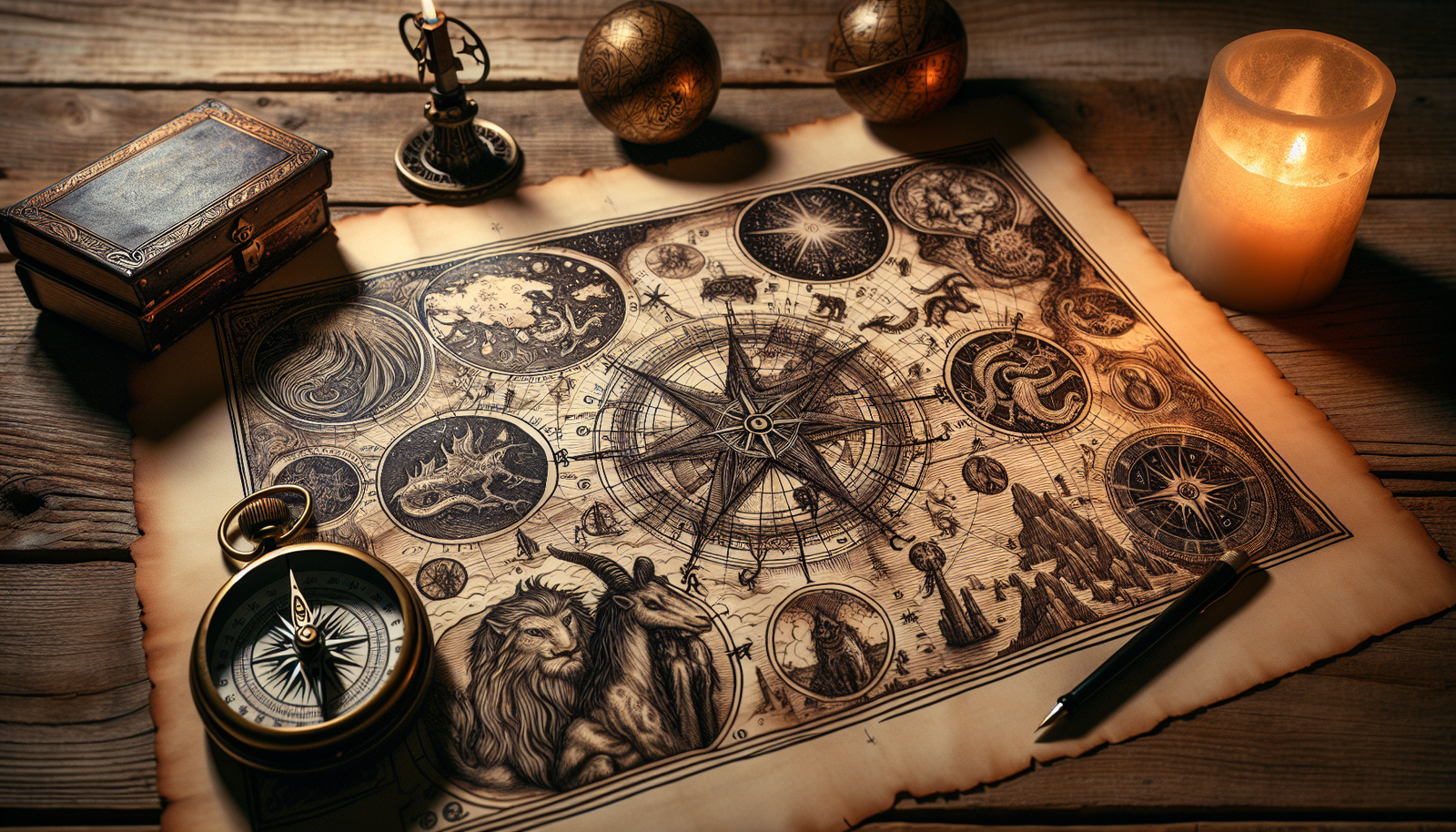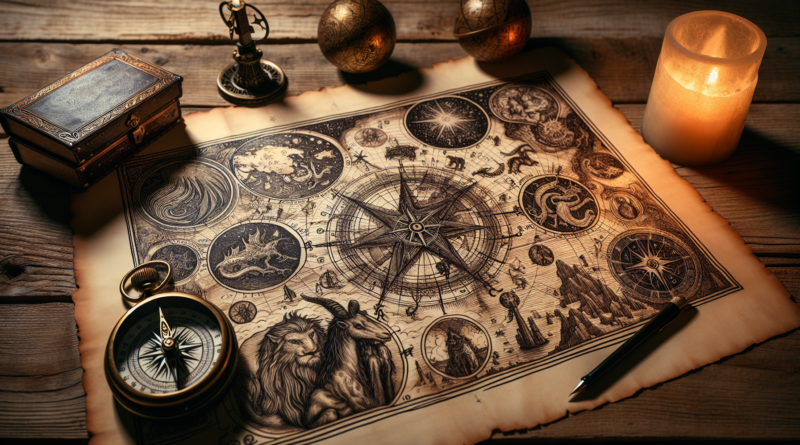Mythological Map Making
Embark on an enchanting journey through “Mythological Map Making,” a captivating exploration that offers you a unique merger of ancient legends and modern cartography. You’ll traverse through the intriguing universe that brings together stories of gods, celestial bodies, magical beasts and intricate charts – all marinated in the enchanting sauce of mystery and innovation. The skillful amalgamation of old-world mythology and art with cutting-edge map-making sets your imagination soaring to realms unknown. As you journey with us, you’ll encounter mythical creatures, stumbling upon Cerberus at a crossroad or finding Orion pinned upside down in the stars, all situated beautifully within a well-crafted, modern geographical framework. The article brilliantly explores how these seemingly disconnected disciplines can become facets of the same gem, creating an enthralling narrative that is sure to leave you spellbound.

Understanding Mythological Map Making
Definition of mythological map making
So, what is mythological map making? It’s the art of creating maps that depict the geographical aspects and locations of the mythologies of various cultures. Their designs are grounded in the stories, beliefs, and legends of different societies. These maps track everything from the abodes of the gods to the routes taken by heroes, all while providing a visually rich interface for understanding these widely varied narratives.
History and origin of mythological map making
The tradition of mythological map making dates back thousands of years. In fact, it’s as old as the myths themselves. Our ancestors had a knack for storytelling, and part of that storytelling often involved creating tangible depictions of the incredible worlds they envisioned. And so, they would draw maps, etch them onto surfaces, or stitch them into textiles, documenting geographical representations of their cosmologies and epic sagas.
Significance of mythological maps in different cultures
Studying mythological maps grants you a unique peek into the worldviews of different cultures. Each map lays bare a culture’s values, belief systems, and understanding of the physical and metaphysical world. It’s like taking a journey through time, able to see how the ancient Greeks viewed their universe or how the Norse charted out their nine realms
Sources of Mythological Maps
Ancient texts and epic tales
One of the primary sources for mythological maps is ancient texts and epic tales. These narratives, filled with larger-than-life characters and grand adventure, often describe geography in great detail. By piecing together these descriptions, researchers can construct a map of the world as it was envisioned in these tales.
Folklore and oral tradition
Folklore and oral traditions are another rich source of material for mythological maps. The stories passed down through generations often contain descriptions of landmarks, sacred sites, and legendary cities, providing the perfect raw material for a mythological map.
Archaeological findings
Rich findings from archaeological sites also contribute significantly to mythological mapmaking. These artifacts, ranging from engraved tablets to murals, often depict the geography of the myths that were integral to the civilizations that produced them.
Symbols in Mythological Maps
Common symbols and their meanings
Mythological maps are often rich with symbolism, and understanding these symbols is crucial to understanding the map itself. You might encounter common symbols like serpents, representing cosmic forces or the underworld, or trees, often symbols of life or connections between different realms.
Symbolism in different cultures
Symbols can vary greatly between cultures. For example, in Greek mythology, an eagle often represents Zeus, whereas in Norse mythology, the same bird could represent Odin. Likewise, the interpretations of colors, shapes, and natural elements can vary significantly across cultures.
Evolution of symbols through history
The interpretation and use of symbols have evolved through history, influenced by cultural diffusion, religious changes, and shifts in societal understanding. A symbol that meant one thing in an older myth could have a drastically different meaning in a later one, adding a fascinating layer of complexity to the study of these maps.

Techniques in Mythological Map Making
Hand-drawn cartography
Traditional mythological maps were hand-drawn, with minute attention to detail. This meticulous process involved not just an understanding of the myths but also artistic skill and a keen sense of geography.
Digital tools and techniques
In the modern age, digital tools have become an integral part of mythological map making. Software advancements now allow for the creation of intricate and aesthetically appealing maps, complete with the capability to zoom, annotate, and layer the maps for a more profound interaction with the myth.
Hybrid techniques
In addition to purely digital or hand-drawn methods, many mapmakers blend the two to create hybrid maps. This could involve hand-drawing the initial design, then digitizing the map for color, texture, and effects.
Challenges in Mythological Map Making
Deciphering ancient texts
Interpreting and understanding ancient texts can be a serious challenge. These texts often contain terminology that has changed or been lost over time, and issues of translation frequently arise.
Interpreting symbols
Each symbol in a mythological map requires careful interpretation. The challenge here is not simply to decipher what a symbol represents but to understand what it meant within the culture and time period it came from.
Preserving accuracy while updating designs
Maintaining the authenticity and accuracy of the original myth while creating a visually appealing and accessible map presents another unique challenge. Striking the right balance between aesthetics and authenticity can be tricky, but it’s essential to preserving the integrity of the myths.
Science Behind Mythological Map Making
Role of geography and landscape
Creating an accurate mythological map requires a sound knowledge of geography. Understanding how landforms influence culture and mythology is crucial in the mapping process. Rivers, mountains, and forests don’t just define physical boundaries; they also play significant roles in mythological narratives.
Understanding ancient astronomy
Considering the importance of celestial beings in mythology, an understanding of ancient astronomy is critical. The positions of stars, constellations, and planets often form integral parts of mythological tales and are frequently reflected in mythological maps.
Influence of climate and ecosystems
Climate and ecosystems have influenced myths and, consequently, mythological maps. For instance, societies based in desert regions often have water-related deities, whereas those in forested areas may have tree or animal spirits. Understanding this can help you create a more meaningful and authentic mythological map.
Applications of Mythological Maps
Use in modern fantasy genre
Mythological maps have found a growing audience in the modern fantasy genre. They are used in books, films, and TV shows to guide viewers through fictional universes, bringing a touch of authenticity to these fantastical worlds.
Applications in historical research
Mythological maps are invaluable tools for historical research. They offer insight into the beliefs and worldviews of ancient cultures, providing a rich framework for interpreting archaeological findings, literature, and art.
Role in video games and virtual reality
In video games and virtual reality, mythological maps are used to build immersive environments, providing players with both a resource for navigation and a tool for deepening the narrative experience.
Famous Mythological Maps
Maps from Greek mythology
Greek mythology offers a great deal of material for map making, from the lofty peak of Mount Olympus to the dark depths of the underworld. These maps enable a more tangible understanding of the many epic legends of the Greek gods and heroes.
Norse mythological maps
The intricate cosmology of Norse mythology, with its iconic nine realms and the world tree Yggdrasil, is a compelling subject for map-making. These maps often provide a detailed visualization of this uniquely interconnected universe.
Mythological maps from Indian epics
Indian mythology, particularly the epics such as the Ramayana and Mahabharata, furnishes a wealth of geographic detail. These maps not only represent the physical journeys of the heroes but also embody the moral and spiritual quests inherent in these stories.
The Art of Mythological Map Making
Influence on modern map making
The art of mythological map-making has greatly influenced modern cartography. The practice of using symbols to represent geographical features, for instance, traces its roots back to this ancient art.
Artistic elements in mythological maps
Every mythological map is not just a geographical representation, but also a work of art inhabiting its unique style, color scheme, and aesthetic. The artistic elements imbued in these maps make them captivating visual narratives.
Museum exhibitions and collections
As recognized works of art and history, mythological maps have made their way into museums worldwide. They are exhibited for their artistic merit and their historical significance, edifying visitors on various ancient cultures and their narratives.
Future of Mythological Map Making
Influence of technology on map making
With developments in technology, specifically in digital tools and augmented reality, the art of mythological map making is poised for some exciting advancements. Expect to see more interactive and immersive maps that take you on a virtual journey through mythical landscapes.
New trends in map making
The fusion of art and technology has injected new vitality into the field. More artists and designers are venturing into the spectrum, creating maps that blend traditional techniques with digital innovation to produce compelling visual narratives.
Potential developments in the field
Looking ahead, we can anticipate even more intriguing developments in mythological map making. Researchers might delve more deeply into less explored myths and folklore, and augmented reality could offer even more immersive experiences. In short, the future of mythological map making is as promising and diverse as the countless myths it gives life to.

